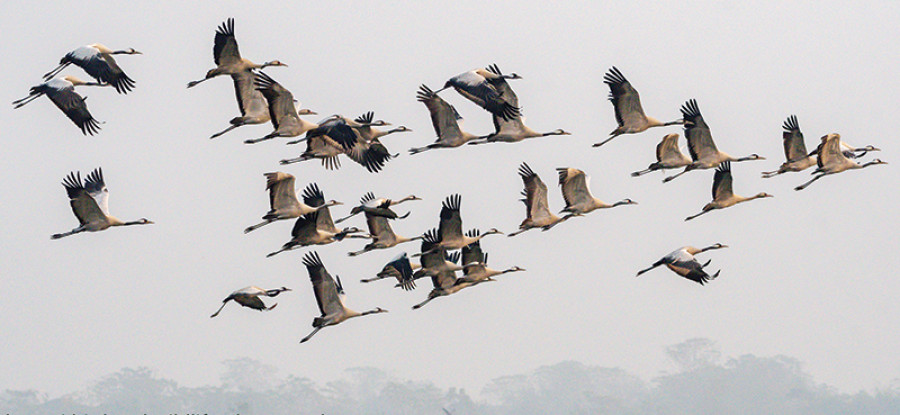Climate & Environment
Conservationists worried about dwindling number of common cranes
The number of migratory common cranes coming to the country has been decreasing of late due to shrinking paddy fields and wetlands, conservationists say.
Ramesh Kumar Paudel
Conservationists are worried about the conservation of common cranes, a bird species locally known as karyang kurung, that migrate to Nepal every year in winter. According to the Bird Education Society, an organisation working for bird conservation, the number of common cranes migrating to the country is dwindling in recent years.
“Dibyanagar in the western part of Chitwan is the main habitat of the bird species. They make their way from as far away as Mongolia by flying thousands of kilometres,” said Ramesh Chaudhary, the chairman of the society. According to him, Dibyanagar’s vast paddy fields and wetland are what attract the migratory birds to the place.
Common cranes usually arrive in the area in the month of November and stay till February every year.
“They arrive after the paddy harvest season. They glean the leftover grains in the fields and stay on the banks of the Narayani river,” said Chaudhary.
However, the decreasing number of common cranes in the country has worried conservationists.
According to Hemsagar Baral, a senior ornithologist, large flocks of the bird species used to be seen in the districts near the Koshi and Karnali rivers, including Saptari, Siraha, Kailali and Bardiya, among others.
“Only a handful of this bird species can be spotted in these places nowadays,” said Baral.
The number of common cranes coming to the country has been decreasing of late due to shrinking paddy fields and wetlands.
“We had counted 152 common cranes in the Dibyanagar area five years ago. The number was around 80 last year,” said Bashu Bidari, another ornithologist working for the conservation of birds in the country. He urged the government authorities, people’s representatives and the local residents to work hand in hand to conserve the bird species.
The common cranes migrate towards the south from Mongolia and other countries every year, reaching as far as Gujarat and Rajasthan in India to avoid the extreme cold.
“Government authorities in India manage their fields and plant crops to conserve the migratory common cranes. But in Nepal, neither the government nor local residents pay attention to conserve the bird species,” said Bidari.
In Dibyanagar, the local residents are gradually switching to vegetable farming, poultry farming and fish farming. As a result, the vast paddy fields in the area are shrinking along with the wetland.
“The karyang kurung will not come to Dibyanagar in the future if we fail to create a suitable environment for them. We have started talking to the villagers and aware them about the importance of the migratory bird and its conservation,” said Chaudhary. “We can conserve the common cranes in Dibyanagar by conserving a few bighas of paddy fields. The area can turn into a tourist destination for bird watchers.”
Nepal, a haven for birding, hosts 887 bird species, including the Spiny babbler (Turdoides nipalensis) which is found only in Nepal. Various species of birds from as far away as Siberia migrate to several places in the country every year. However, the loss of habitat due to human encroachment, haphazard extraction of riverbed materials, excessive fishing and bird hunting threatens the survival of bird species in the country.




 11.12°C Kathmandu
11.12°C Kathmandu1.jpg)











